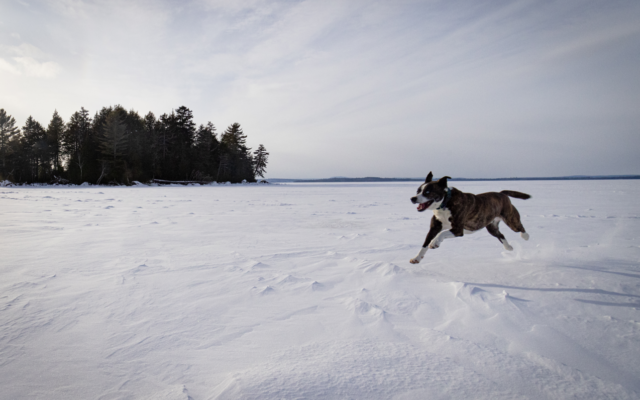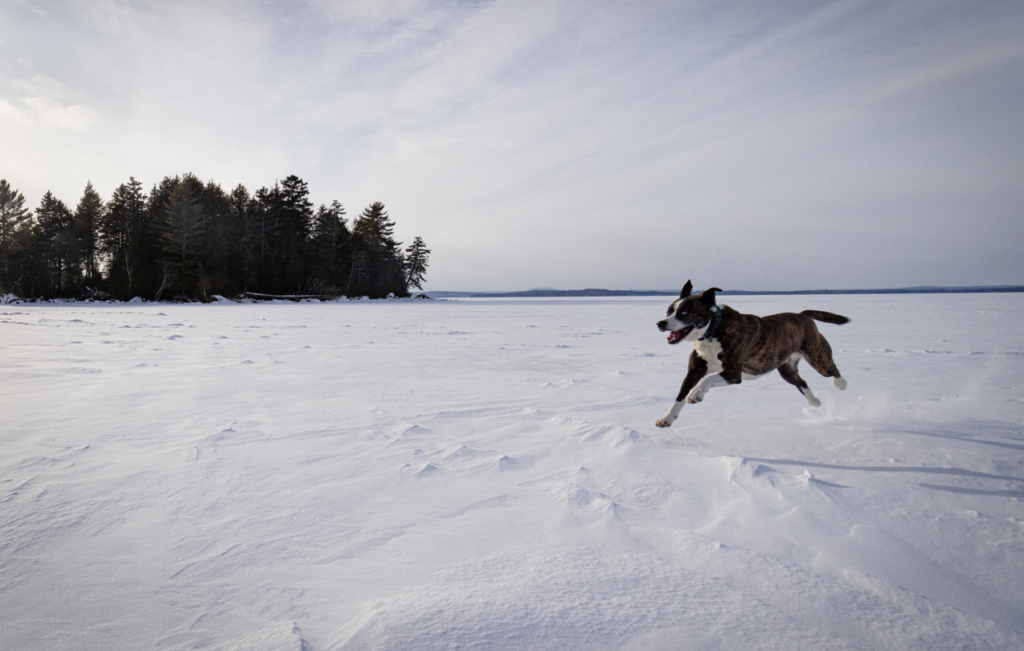
Here are some of the winter recreation pleasures of Moosehead Lake
By Aislinn Sarnacki
Skiing across Moosehead Lake, I imagined the blowing snow to be sand. Drifts became dunes. The frozen lake became a desert.
A frigid gust brought me back to reality. The temperature hovered in the low teens, with a negative wind chill. I wouldn’t be seeing any camels or cacti.
It’s easy to become fanciful when skiing for miles over such an open expanse. Covering nearly 75,000 acres, Moosehead Lake is the largest lake in Maine, and the largest lake completely within the boundaries of New England. For people like me who struggle to visualize acres, it’s roughly 40 miles long by 10 miles wide.

LAKE RUN — Juno enjoys running off leash on the frozen surface of Moosehead Lake on Jan. 23, near Evergreen Point.
This sprawling body of water, home to more than 80 islands, draws recreationists year round. As do the surrounding mountains. And in my opinion, the area is a particularly special place to visit in the winter.
I remember my first visit to Moosehead during the wintertime, years ago. Driving into downtown Greenville, I stopped at a convenience store to find nothing but snowmobilers fueling up at the gas pumps. That’s when I realized just how serious people were about their winter sports in the area.
I’ve returned to Moosehead many times over the years, but it wasn’t until recently that I enjoyed an extended stay. For two nights, I stayed at my cousin’s house, which is located on the shore of Moosehead Lake in a town called Beaver Cove.
It was difficult to narrow down my list of possible adventures for the mini staycation. I contemplated hiking in Little Moose Public Land, which features miles of trails to mountain peaks and remote ponds. I also considered visiting Big Moose Ski Area, where I could downhill ski (on the easier trails, as I’m new to the sport) and cross-country ski on groomed trails.
But in the end, I settled on hiking Mount Kineo, one of the most distinctive landmarks in the region. Accessible only by water, you have to take a boat to Kineo during the summer. But during the winter, when the lake ice is safe, you can walk or ski over to the mountain. And that’s what we did.
Starting at the Rockwood boat launch, we followed a snowmobile route about a mile across the ice to the peninsula where the mountain is located. Once on the peninsula, we continued on cross-country skis, entering Mount Kineo State Park to follow a trail along the shore of the lake.
With sheer cliffs that rise 700 feet above the surface of the lake, Mount Kineo tops off at 1,789 feet above sea level. Turning away from the lake, we hiked up the steep Indian Trail to the summit, then descended on the more gradual Bridle Path.
Along the way, we were rewarded with open views of Moosehead Lake, which was dotted with colorful ice fishing shacks and abuzz with snowmobiles. On the horizon, the mountains of the 100-Mile Wilderness were a deep periwinkle, their tops dusted with snow.
On Kineo’s summit sits a converted fire tower with an observation deck that offers a 360-degree view of the region. Climbing it requires care in the winter, when ice and snow make the steps slippery. And at the top, you’ll likely be slapped in the face by freezing wind. But the views are worth it.
We finished our outing with a pepperoni pizza and beer at Rockwood Bar and Grill, which I’d highly recommend for their comfort food and friendly service.
While at the restaurant, we learned that three snowmobilers had crashed through the ice nearby, at the mouth of Moose River. Luckily, they were quickly rescued by Rockwood Fire and Rescue. The incident reminded me of the importance of staying away from flowing water while traveling on ice.
That’s not the only danger I was reminded of that evening. While driving back to Beaver Cove, I spotted movement on the side of the road. It was a moose stomping through the snowbank. After a few seconds of what appeared to be indecisiveness and confusion, the beast turned away from the road and hightailed it into the woods. Car-moose collision avoided.
Though I was only in the area for a few days, I started to get a sense of a comradery that exists in the community. At restaurants, people called out to each other in greeting. On the ice, snowmobilers waved as they passed us by. I at once felt welcome and envious that I didn’t live there.
It was quite a treat to be staying in a house that’s right on the lake. On our last morning there, we walked out of the house, clipped into our cross-country skis and struck out across the ice to visit Lily Bay State Park.
An especially popular destination for families in the summer, the lakeside park offers some of the best campsites to be had in Maine. That day, the park was quiet. We didn’t see another soul, aside from a white-tailed deer stepping gingerly through the snow.
As we skied along the park roads and trails, I attempted to read the story stamped into the snow. Wildlife tracks dotted the forest floor — the cloven hoofprints of deer, the leaping pattern of squirrels and the tiny imprints left by mice and voles.
We sat on the beach in the sun, blocked from the wind, and once again, I could imagine the snow as sand.